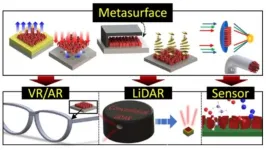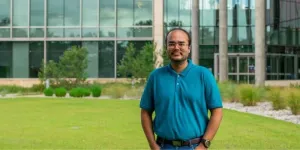(Press-News.org) Results from a study just released by Columbia University Mailman School of Public Health show major inequities in the location of lead service lines across New York City. Communities with large numbers of Hispanic/Latino residents and those with children who are already highly vulnerable to lead exposure from numerous sources are disproportionately impacted by water service lines that may contain lead. The study findings are published online in the journal Environmental Health Perspectives.
There is no safe level of lead exposure for children. Even at lower levels of exposure, lead is associated with impaired cognitive function, attention-related behavioral problems, and diminished academic performance. Lead service lines are a significant source of lead to drinking water, even when source water contains no lead.
Out of over 850,000 residential service line records analyzed, over 136,000 (16 percent) were potentially made of lead, and over 227,000 (27 percent) were made of an unknown material, which could also include lead. In total, over 40 percent of service lines in the city could contain lead.
The largest absolute number of potential lead and unknown service lines were in Brooklyn (91,377) and Queens (66,508), respectively. Relative to other boroughs, a larger proportion of service lines with potential lead were in the Bronx (21 percent) and Queens (20.5 percent); Brooklyn had the largest proportion of service lines made of unknown material that might also contain lead (33 percent).
The researchers determined whether service lines that could contain lead were evenly distributed throughout NYC. The researchers established that communities with higher proportions of Hispanic/Latino residents had a higher prevalence of service lines that could contain lead. The researchers also identified that potential lead service lines were also more likely to impact communities where children were already highly vulnerable to lead from all sources, including paint, dust, and water.
“Our objective was to evaluate whether the location of lead service lines was associated with community race, ethnicity, and child vulnerability to total lead exposure,” said Anne Nigra, PhD, assistant professor of Environmental Health Sciences at Columbia Public Health. “Our goal was to help inform equitable interventions, especially the replacement of all lead service lines. These findings support that policy makers in NYC and NY State should consider these inequities in lead service line locations when prioritizing lead service line replacement efforts. They should work to immediately identify and replace all lead service lines.”
The researchers also found differences within boroughs of the city. Specifically, potential lead service lines were associated with higher proportions of non-Hispanic White and non-Hispanic Asian residents in the Bronx and Manhattan, and higher proportions of non-Hispanic Black residents in Queens.
Although the U.S. EPA Lead and Copper Rule requires public water systems to conduct routine compliance monitoring for lead at taps throughout the distribution system and intervene to reduce lead corrosion, current regulations are inadequate to reduce water lead exposure and eliminate racial/ethnic disparities in water lead exposure, according to the researchers.
The Infrastructure Investment and Jobs Act of 2021 allocated billions of dollars to improving drinking water quality across the US, but individual states set the prioritization criteria for determining which municipalities receive funding for lead service line replacement efforts. Under NYS’s current lead service line replacement program, municipalities are prioritized for funding if those municipalities are low income (median household income <150 percent of regional average), are likely to have a high number of lead services lines (500 or more homes constructed before 1939), and have a high percentage of children with elevated blood lead levels (>0.5 percent children with blood level >5 μg/dL.
“The high number of service lines that might contain lead in residential buildings throughout NYC and the significant inequities in lead service line prevalence underscores the importance of prioritizing lead service line replacement for the most impacted communities,” noted Nigra. “Our findings suggest that NYC communities with known potential for child lead exposure from paint and dust may also be highly vulnerable to water lead from lead service lines.’
Nigra and colleagues point out that numerous studies have called for justice-oriented interventions and policies that protect the most highly exposed communities. And while advancing environmental justice necessitates that all lead service lines should be identified and replaced, efforts should also prioritize the most impacted communities. “Improvements to public health demands attention to all potential lead sources, including water, soil, and paint.,” observed Nigra.
“Future analyses in New York and around the nation should consider the pathways through which these inequities arose, including assessing differential disinvestment by neighborhood and patterns of residential segregation.”
Co-authors are Wil Lieberman-Cribbin, Columbia Mailman School of Public Health; Benjamín C. Bostick and Steven N. Chillrud, Lamont-Doherty Earth Observatory, Columbia University; and Daniel Carrión, Yale University School of Public Health.
The study was supported by NIH (DP5OD031849), National Institute of Environmental Health Sciences (P30ES009089), Eunice Kennedy Shriver National Institute of Child Health and Human Development (P2CHD058486).
According to Rob Hayes, director of Clean Water with Environmental Advocates NY, who was not involved in the research, studying the findings by Columbia Public Health researchers have direct relevance to NY state policy relevance. When asked about the relevance of these findings for state and local policy, he said:
"The extraordinary research of Dr. Nigra and her colleagues at Columbia Mailman School confirms what we have long suspected: that the most vulnerable members of our society are most at risk of dangerous lead exposure when they turn on the tap. Every New Yorker deserves clean water - it's long past time to replace all of the lead water service lines causing contamination. While New York is receiving an influx of federal funding to get the lead out, it won't be nearly enough to replace every lead pipe, leaving behind too many New Yorkers in low-income communities and communities of color. It's now up to city and state leaders, from the Mayor to the Governor, to equitably distribute available funding and enact new investments and policies to put New York on the path to 100 percent lead pipe replacement in the next 10 years. We hope that Governor Hochul will sign the Lead Pipe Right to Know Act and make New York a leader in water transparency."
Columbia University Mailman School of Public Health
Founded in 1922, the Columbia University Mailman School of Public Health pursues an agendaof research, education, and service to address the critical and complex public health issues affecting New Yorkers, the nation and the world. The Columbia Mailman School is the fourth largest recipient of NIH grants among schools of public health. Its nearly 300 multi-disciplinary faculty members work in more than 100 countries around the world, addressing such issues as preventing infectious and chronic diseases, environmental health, maternal and child health, health policy, climate change and health, and public health preparedness. It is a leader in public health education with more than 1,300 graduate students from 55 nations pursuing a variety of master’s and doctoral degree programs. The Columbia Mailman School is also home to numerous world-renowned research centers, including ICAP and the Center for Infection and Immunity. For more information, please visit www.mailman.columbia.edu.
END
Lead service lines in New York City disproportionately impact Hispanic/Latino communities and children already at risk of lead exposure
Findings support immediate need for full identification and replacement of lead service lines in NYC and NY State
2023-08-30
ELSE PRESS RELEASES FROM THIS DATE:
Vision for future micro-optical technology based on metamaterials
2023-08-30
Metasurfaces, also known as invisibility cloak technology, are an artificial material adept at manipulating. With metasurfaces allowing for lenses to be reduced to one 10,000th the size of conventional lenses, they are generating considerable interest as optical components allowing miniaturization of optical systems for the next generation of virtual and augmented reality as well as LiDAR. If metasurfaces become commercially viable, overcoming the challenges of complex manufacturing processes and high production costs, Korea could gain a significant technological edge ...
No worries: online course to help you stop ruminating
2023-08-30
An online course designed to curb negative thinking has had strong results in helping people reduce the time they spend ruminating and worrying, a new study from UNSW Sydney has shown.
And researchers say the online course, which will soon be hosted on the Australian Government funded online clinic This Way Up and is free with a prescription from a clinician, was found to significantly improve the mental health of the people who participated in the study. The trial was part of a collaboration between UNSW, the Black Dog Institute and The Clinical Research Unit for Anxiety and Depression at St ...
Boosting neuroscience training to help children flourish
2023-08-30
Professionals working with children and young people will be offered training in brain science in an Australia-first initiative between The University of Queensland (UQ) and the Australian Research Alliance for Children and Youth (ARACY) through the Thriving Queensland Kids Partnership (TQKP).
Thriving Kids Brain Builders is a neuroscience translation initiative being developed with UQ’s Queensland Brain Institute (QBI) for people working across the health, education, social and community services, justice and housing sectors.
QBI ...
Exercise could help one of prostate cancer treatment’s most-common and devastating side effects
2023-08-30
Prostate cancer is one of the most common forms of cancer in the world, but not only does it put the lives of those diagnosed at risk, but can also severely impact patient quality of life due to side-effects of treatment.
One such side-effect commonly reported by patients is sexual dysfunction – however, a new long-term clinical trial led by Edith Cowan University (ECU) and presented at the American Society of Clinical Oncology Breakthrough Meeting in Japan, has revealed there is a therapy which may help combat this ...
Can this forest survive? Predicting forest death or recovery after drought
2023-08-30
How long can trees tolerate drought before the forest dies?
Researchers from UC Davis can now predict which forests could survive despite future drought. Their new method links precipitation to tree growth, and it can help people decide where to put their resources as climate change affects patterns of snow and rainfall that impact the health of forests.
“If a forest is doing OK, but in the future we know it’s likely to get only half the average rainfall it used to get, we can calculate the likelihood ...
How Norway is helping to restore humanity inside U.S. prisons
2023-08-30
As part of an innovative prison reform program, the Oregon State Penitentiary created a healing garden on its grounds to provide some respite from the concrete and resemble the outside world. One incarcerated man who had spent most of the past two decades in solitary confinement described going to the garden as, “the first time I walked on grass in 20 years.”
“Many of us have found beauty in weeds and flowers growing through the cracks in the pavement,” he told UC San Francisco researchers, who helped institute and then evaluated the reforms. “There is both beauty and inspiration in knowing that we, ...
Statistics can help us figure out how historic battles could have turned out differently, according to experts
2023-08-30
Quantifying Counterfactual Military History probes whether historic battles and military interventions could have turned out quite differently
Oxford, U.K., 30 August 2023 – Statistical methods can evaluate whether pivotal military events, like the Battle of Jutland, American involvement in the Vietnam war or the nuclear arms race, could’ve turned out otherwise, according to a new book.
Military historical narratives and statistical modelling bring fresh perspectives to the fore in ...
Using neuroscience to stop phantom braking
2023-08-29
EAST LANSING, Mich. — Recently, when customers began complaining that their vehicles with driver-assistance technologies were “phantom braking” or slamming on the brakes without any visible obstacles present, researchers at Michigan State University wanted to learn more about this phenomenon — why it happens and how to stop it.
“Frequent phantom braking incidents can erode confidence in autonomous driving technologies,” said Qiben Yan, an assistant professor in the College of Engineering. “If riders perceive the technology as unpredictable or unreliable, they’ll be less likely to embrace it.”
Autonomous vehicles have a vision system, ...
Sensitive parenting and preschool attendance may promote academic resilience in late preterm infants
2023-08-29
Late preterm infants, or infants born between 34 and 36-6/7 weeks gestation, are the majority of infants born preterm, and are at greater risk for academic delays compared to full term infants.
Certain factors, including a low level of maternal education, prenatal tobacco use, twins/multiple gestation and male sex increased the risk for deficits in math and reading by kindergarten for late preterm infants, a new study finds.
However, sensitive parenting and preschool enrollment are two possible ways to counter the risk of being born late preterm, and to promote academic resilience.
“Our findings highlight an opportunity for pediatric providers to offer prevention strategies ...
New imaging technique could provide clearer images for oncologists
2023-08-29
A multidisciplinary team lead by University of Texas at Arlington mathematics Assistant Professor Souvik Roy is on a mission to improve medical imaging using a new technique called quantitative photoacoustic tomography (QPAT).A multidisciplinary team lead by University of Texas at Arlington mathematics Assistant Professor Souvik Roy is on a mission to improve medical imaging using a new technique called quantitative photoacoustic tomography (QPAT).
QPAT is an imaging modality that combines ultrasound, which is an imaging technique that uses sound waves to image features inside ...
LAST 30 PRESS RELEASES:
Tracing the quick synthesis of an industrially important catalyst
New software sheds light on cancer’s hidden genetic networks
UT Health San Antonio awarded $3 million in CPRIT grants to bolster cancer research and prevention efforts in South Texas
Third symposium spotlights global challenge of new contaminants in China’s fight against pollution
From straw to soil harmony: International team reveals how biochar supercharges carbon-smart farming
Myeloma: How AI is redrawing the map of cancer care
Manhattan E. Charurat, Ph.D., MHS invested as the Homer and Martha Gudelsky Distinguished Professor in Medicine at the University of Maryland School of Medicine
Insilico Medicine’s Pharma.AI Q4 Winter Launch Recap: Revolutionizing drug discovery with cutting-edge AI innovations, accelerating the path to pharmaceutical superintelligence
Nanoplastics have diet-dependent impacts on digestive system health
Brain neuron death occurs throughout life and increases with age, a natural human protein drug may halt neuron death in Alzheimer’s disease
SPIE and CLP announce the recipients of the 2025 Advanced Photonics Young Innovator Award
Lessons from the Caldor Fire’s Christmas Valley ‘Miracle’
Ant societies rose by trading individual protection for collective power
Research reveals how ancient viral DNA shapes early embryonic development
A molecular gatekeeper that controls protein synthesis
New ‘cloaking device’ concept to shield sensitive tech from magnetic fields
Researchers show impact of mountain building and climate change on alpine biodiversity
Study models the transition from Neanderthals to modern humans in Europe
University of Phoenix College of Doctoral Studies releases white paper on AI-driven skilling to reduce burnout and restore worker autonomy
AIs fail at the game of visual “telephone”
The levers for a sustainable food system
Potential changes in US homelessness by ending federal support for housing first programs
Vulnerability of large language models to prompt injection when providing medical advice
Researchers develop new system for high-energy-density, long-life, multi-electron transfer bromine-based flow batteries
Ending federal support for housing first programs could increase U.S. homelessness by 5% in one year, new JAMA study finds
New research uncovers molecular ‘safety switch’ shielding cancers from immune attack
Bacteria resisting viral infection can still sink carbon to ocean floor
Younger biological age may increase depression risk in older women during COVID-19
Bharat Innovates 2026 National Basecamp Showcases India’s Most Promising Deep-Tech Ventures
Here’s what determines whether your income level rises or falls
[Press-News.org] Lead service lines in New York City disproportionately impact Hispanic/Latino communities and children already at risk of lead exposureFindings support immediate need for full identification and replacement of lead service lines in NYC and NY State




